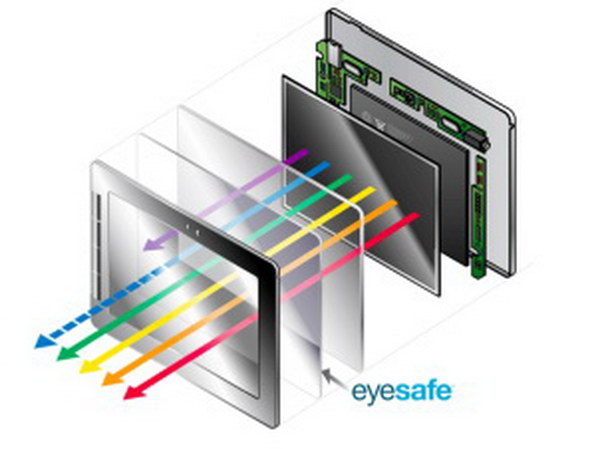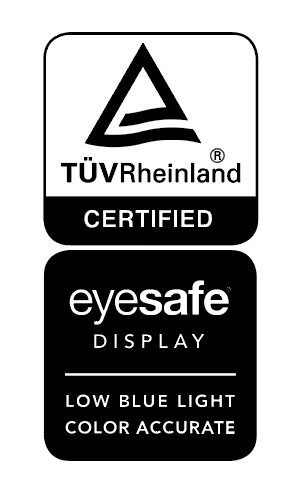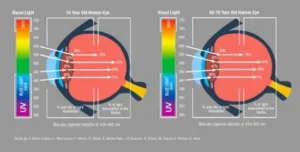There has been a lot of talk about blue light from displays and other LED sources recently. On March 6th, TÜV Rheinland announced an Eyesafe Display “Standard”, an industry guide to improve display users’ eye health. TÜV Rheinland group is a provider of independent inspection services and was founded nearly 150 years ago.

The group maintains a worldwide presence of more than 20,000 people. They inspect technical equipment, products and services; oversees projects, and help to shape processes and information security for companies.
 An Eyesafe filter eliminates short wavelength blue and reduces medium wavelength blue. (Credit: Eyesafe)
An Eyesafe filter eliminates short wavelength blue and reduces medium wavelength blue. (Credit: Eyesafe)
Eyesafe is not a trade name for a standard from TÜV Rheinland, nor is it a part of the TÜV Rheinland Group. Rather it is an independent company, headquartered in Minneapolis, Minnesota and formerly known as Healthe, that has worked on eye safety in terms of blue light exposure for a number of years. Besides providing services and specification recommendations related to blue light to display manufacturers, Eyesafe sells blue light reducing filters for displays. TÜV Rheinland has partnered with Eyesafe to publicize the Eyesafe Display Standard and test displays to see if they qualify for the “Eyesafe” logo.
Four months ago, Bob Raikes, who had been following blue light problems in general and Eyesafe in particular, wrote a Display Daily on the topic. His information came from the 1st annual Blue Light Summit, a webinar co-produced by TÜV Rheinland and Eyesafe. This was an on-line forum and the second Blue Light Summit is scheduled for November, 2020. The results of the Blue Light Summit 2019 can be watched on its website, or on Vimeo. Bob found the portion of the video from Stanley Liu, TÜV Rheinland Technical Competence Center Director, particularly interesting. His remarks begin at the 36:49 point of the video. If you are interested in the blue-light eye safety of displays, the entire 1:14:11 video is probably worth watching.
 Difference between young and old eyes in their response to blue light. (Credit: Eyesafe)
Difference between young and old eyes in their response to blue light. (Credit: Eyesafe)
Blue light can be divided into three wavebands for consideration of eye safety issues. The shortest waveband is about 380-415nm, the middle waveband is 415-455nm and the longer waveband starts at 455nm. The shortest is UV and deep violet and is the most biologically active. It also provides little brightness and little “blueness” to an image shown on a display screen. Basically, since this waveband does not provide any benefits and is biologically quite damaging to the eye, it should not be present in the emission from a display.
The middle blue waveband, 415 – 455nm, is what everyone would call “blue.” Eyesafe calls it High Energy Visible Blue Light (HEV). Light in this waveband is somewhat damaging to the eye and should be minimized. In order to get a good blue primary color, however, it cannot be eliminated completely. The third blue waveband starts at 455nm and is what commonly would be called “Cyan.” The upper limit of this waveband is flexible, with Eyesafe using 480nm and others using up to 500nm. The light in this waveband does minimal damage to the eye and contributes both to the color and white point of the display so it is desirable light.
One thing Eyesafe points out is the difference between young and old eyes. As people age, the lens of the eye become less transparent to blue light, as illustrated in the figure above. Due to the higher transmission of young lenses, the retina of young people gets exposed to higher doses of blue light than an older person viewing the same display. Therefore, in a display targeting young people, reducing blue light is more important than it would be in a display for an older person, for example, me.
Unfortunately, limiting this mid-band blue definitely affects the blue primary color. In the Eyesafe standard, for a display to rate using the logo, its color gamut must be at least 72% of NTSC. In 2020, this is a very small color gamut and would not be acceptable by TV Marketing groups as a TV color gamut, although it probably is acceptable for most laptop applications other than color-critical ones like video or photo editing.
 TÜV Rheinland/Eyesafe logo (Credit: TÜV Rheinland)
TÜV Rheinland/Eyesafe logo (Credit: TÜV Rheinland)
The complete Eyesafe Display “Standard” can be downloaded for free here. If a display maker uses TÜV Rheinland to certify its displays meet this standard, the company can then use the Eyesafe logo, shown above, on its products. Dell, for example, is a participant in this program and is introducing products with the Eyesafe logo. One requirement in the specification is the display must have an International Commission on Non-Ionizing Radiation Protection (ICNIRP) blue light toxicity factor measured in ?W/cm² vs. total lux must be less than 0.085. Nowhere in the specification or on the Eyesafe website is there any indication of what this value is for an ordinary display. Is a 300 nit LCD TV a problem? Is a 1000 nit HDR TV a problem? I don’t know.
By the way, you can get reduced blue light for eye safety without the Eyesafe logo. For example, Samsung recently announced OLED displays with reduced blue light. According to Samsung, this not only promotes eye safety but it reduces power consumption as well.
Eyesafe says there is considerable scientific research behind their standard. They summarize this research and post excerpts from it at https://eyesafe.com/research/.
Much of the recent discussion of blue light from displays focuses not on eye safety but melatonin production. This topic is briefly touched on in the Eyesafe logo requirement, but the focus of the standard is on eye safety, not melatonin. By stimulating retinal ganglion cells, blue light in the 460 to 480 nm wavelength range suppresses melatonin production and therefore plays an important role in alertness, memory, attention span, learning ability and cognitive performances.
When you want to be alert, e.g. in the morning, you want to suppress melatonin production. Many people, especially ones in darker northern countries in winter like my daughter in Amsterdam, want blue light to suppress melatonin production in the morning so they sit under bluish “daylight” lamps while eating breakfast before going to work. Evening is different: people want to lose their alertness and go to sleep so they want more melatonin in their system. An example of this is a teenage boy playing video games after dinner with a display with lots of blue light. His parents should buy him a low-blue light output gaming monitor to encourage him to go to sleep eventually.
Display companies are introducing displays with either low blue light or an evening mode to reduce the blue light from the display. Since I’ve run out of space, this topic will need to wait for another day. –Matthew Brennesholtz

